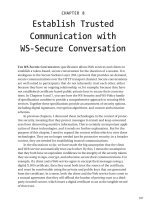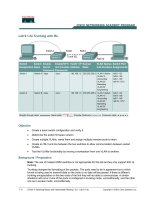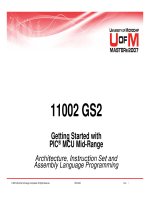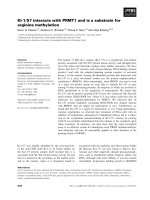AN1199 1 wire® communication with PIC® microcontroller
Bạn đang xem bản rút gọn của tài liệu. Xem và tải ngay bản đầy đủ của tài liệu tại đây (136.79 KB, 16 trang )
AN1199
1-Wire® Communication with PIC® Microcontroller
Author:
Sashavalli Maniyar
Microchip Technology Inc.
INTRODUCTION
This application note introduces the user to the 1-Wire®
communication protocol and describes how a 1-Wire
device can be interfaced to the PIC® microcontrollers.
1-Wire protocol is a registered trade mark of Maxim/
Dallas Semiconductor.
A software stack for the basic, standard speed, 1-Wire
master communication is provided with this application
note along with an example application.
Note:
1-Wire is not related to the UNI/O™ bus.
The UNI/O serial EEPROM family uses a
single wire communication protocol
developed by Microchip. For UNI/O protocol
related application notes, visit the Microchip
web site: .
OVERVIEW OF THE 1-Wire BUS
The PIC microcontrollers have multiple General
Purpose Input/Output (GPIO) pins, and can be easily
configured to implement Maxim/Dallas Semiconductor’s
1-Wire protocol.
The 1-Wire protocol allows interaction with many
Maxim/Dallas Semiconductor parts, including battery
and thermal management devices, memory, iButtons®,
etc.
1-Wire devices provide solutions for identification,
memory, timekeeping, measurement and control. The
1-Wire data interface is reduced to the absolute
minimum (single data line with a ground reference). As
most 1-Wire devices provide a relatively small amount
of data, the typical data rate of 16 kbps is sufficient for
the intended tasks. It is often convenient to use a GPIO
pin of an 8-bit or 16-bit microcontroller in a “bit banging”
manner to act as the bus master. 1-Wire devices
communicate using a single data line and well-defined,
time tested protocols.
Note:
1-Wire Protocol
• The protocol is called 1-Wire because it uses
1 wire to transfer data. 1-Wire architecture uses a
pull-up resistor to pull voltage off the data line at
the master side.
• 1-Wire protocol uses CMOS/TTL logic and
operates at a supply voltage ranging from
2.8V to 6V.
• Master and slave can be receivers and
transmitters, but transfer only one direction at a
time (half duplex). The master initiates and
controls all 1-Wire operations.
• It is a bit-oriented operation with data read and
write, Least Significant bit (LSb) first, and is
transferred in time slots.
• The system clock is not required as each part is
self-clocked and synchronized by the falling edge
of the master.
Prerequisites
The requirements of any 1-Wire bus are:
• The system must be capable of generating an
accurate and repeatable 1 μs delay for standard
speed and 0.25 μs delay for overdrive speed.
• The communication port must be bidirectional; its
output must be open-drain and there should be a
weak pull-up on the line.
• The communication operations should not be
interrupted while being generated.
Note:
Most PIC microcontrollers allow the user
to configure any I/O pin to open-drain as it
is one of the prerequisites.
For recommended pull-up resistance
value, refer to the specific slave device
data sheet
The Idle state for the 1-Wire bus is high. If,
for any reason, a transaction needs to be
suspended, the bus must be left in the Idle
state. If this does not occur and the bus is
left low for more than 120 µs, one or more
of the devices on the bus may be reset.
© 2008 Microchip Technology Inc.
DS01199A-page 1
AN1199
FIGURE 1:
HARDWARE INTERFACE
VCC
VCC
R
VCC
®
PIC Microcontroller
OPERATIONS OF THE 1-Wire BUS
The four basic operations of a 1-Wire bus are Reset,
Write 0 bit, Write 1 bit and Read bit.
Using these bit operations, one has to derive a byte or
a frame of bytes.
The bus master initiates and controls all of the 1-Wire
communication. Figure 2 illustrates the 1-Wire communication timing diagram. It is similar to Pulse-Width
Modulation (PWM) because, the data is transmitted by
wide (logic ‘0’) and narrow (logic ‘1’) pulse widths
during data bit time periods or time slots. The timing
diagram also contains the recommended time values
for robust communication across various line
conditions.
Table 1 provides a list of operations with descriptions
and also implementation steps; this is for standard
speed.
TABLE 1:
DS2411
I/O
1-Wire® Slave Device
GND
A communication sequence starts when the bus
master drives a defined length “Reset” pulse that
synchronizes the entire bus. Every slave responds to
the “Reset” pulse with a logic-low “Presence” pulse.
To write the data, the master first initiates a time slot by
driving the 1-Wire line low, and then, either holds the
line low (wide pulse) to transmit a logic ‘0’ or releases
the line (short pulse) to allow the bus to return to the
logic ‘1’ state. To read the data, the master again
initiates a time slot by driving the line with a narrow low
pulse. A slave can then either return a logic ‘0’ by turning on its open-drain output and holding the line low to
extend the pulse, or return a logic ‘1’ by leaving its
open-drain output off to allow the line to recover.
• Most 1-Wire devices support two data rates:
standard speed of about 15 kbps and overdrive
speed of about 111 kbps.
The protocol is self-clocking and tolerates long inter-bit
delays, which ensures smooth operation in interrupted
software environments.
1-Wire® OPERATIONS
Operation
Description
Implementation
Reset the 1-Wire bus slave devices and get them
ready for a command.
Drive bus low, delay 480 μs.
Release bus, delay 70 μs.
Sample bus: 0 = device(s) present,
1 = no device present
Delay 410 μs.
Write 0 bit
Send ‘0’ bit to the 1-Wire slaves (Write 0 slot time).
Drive bus low, delay 60 μs.
Release bus, delay 10 μs.
Write 1 bit
Send ‘1’ bit to the 1-Wire slaves (Write 1 slot time).
Drive bus low, delay 6 μs.
Release bus, delay 64 μs.
Read bit
Read a bit from the 1-Wire slaves (Read time slot).
Drive bus low, delay 6 μs.
Release bus, delay 9 μs.
Sample bus to read bit from slave.
Delay 55 μs.
Reset
DS01199A-page 2
© 2008 Microchip Technology Inc.
AN1199
FIGURE 2:
1-Wire® TIMING DIAGRAM
Master
Sample
Reset
480 μs
550 μs
960 μs
Write 0
Write 1
Read
Master
Sample
Recovery Time
Between Each
Slot
6 μs
10 μs
15 μs
60 μs
Master
Slave
Register
Pull-Up
© 2008 Microchip Technology Inc.
DS01199A-page 3
AN1199
1-Wire APIs FOR PIC MICROCONTROLLERS
Table 2 provides the 1-Wire functions.
1-Wire® API FUNCTIONS
TABLE 2:
Function Name
Description
drive_OW_low
This function configures the 1-Wire port pin as an output and drives the
port pin to LOW.
drive_OW_high
This function configures the 1-Wire port pin as an output and drives the
port pin to HIGH.
read_OW
This function configures the 1-Wire port pin as an input and reads the
status of the port pin.
OW_write_byte
This function is used to transmit a byte of data to a slave device.
OW_read_byte
This function is used for reading a complete byte from the slave device.
OW_reset_pulse
This function describes the protocol to produce a Reset pulse to a slave
device and also to detect the presence pulse from the slave device. The
1-Wire slave device is identified using this function.
OW_write_bit
This function describes the protocol to write bit information to a slave
device.
OW_read_bit
This function describes the protocol to read bit information from a slave
device.
DS01199A-page 4
© 2008 Microchip Technology Inc.
AN1199
CONCLUSION
REFERENCES
This application note provides an overview of a 1-Wire
protocol and also can be used as a building block to
develop a sophisticated 1-Wire application using API
developed on PIC microcontrollers.
• />• />appnotes.cfm?appnote_number=126
• />3711/t/al
© 2008 Microchip Technology Inc.
DS01199A-page 5
AN1199
APPENDIX A:
1-Wire FUNCTIONS
drive_OW_low
Configures the 1-Wire port pin as an output and drives the port pin to LOW.
Syntax
void drive_OW_low (void)
Parameter
None
Return Values
None
Precondition
None
Side Effects
None
Example
// Driving the 1-Wire bus low
drive_OW_low();
drive_OW_high
Configures the 1-Wire port pin as an output and drives the port pin to HIGH.
Syntax
void drive_OW_high (void)
Parameter
None
Return Values
None
Precondition
None
Side Effects
None
Example
// Driving the 1-Wire bus High
drive_OW_high();
DS01199A-page 6
© 2008 Microchip Technology Inc.
AN1199
read_OW
Configures the 1-Wire port pin as an input and reads the status of the port pin.
Syntax
unsigned char read_OW (void)
Parameters
None
Return Values
Return the status of OW pin.
Precondition
None
Side Effects
None
Example
unsigned char presence_detect ;
// Return the status of OW pin.
presence_detect = read_OW();
© 2008 Microchip Technology Inc.
// Get the presence pulse from 1-Wire slave device.
DS01199A-page 7
AN1199
OW_write_byte
Transmits 8-bit data to the 1-Wire slave device.
Syntax
void OW_write_byte (unsigned char write_data)
Parameters
Send byte to the 1-Wire slave device.
Return Values
None
Precondition
None
Side Effects
None
Example
#define READ_COMMAND_DS2411 0x33
//Send read command to 1-Wire Device DS2411 to get serial number.
OW_write_byte (READ_COMMAND_DS2411);
DS01199A-page 8
© 2008 Microchip Technology Inc.
AN1199
OW_read_byte
Reads the 8-bit information from the 1-Wire slave device.
Syntax
unsigned char OW_read_byte (void)
Parameters
None
Return Values
Returns the read byte from the slave device.
Precondition
None
Side Effects
None
Example
// To receive 64-bit registration number ( 8-bit CRC Code, 48-bit Serial
//Number, 8-bit family code) from the 1-Wire slave device.
unsigned char serial_number [8];
unsigned char temp;
for(temp = 0; temp<8; temp++)
serial_number[temp] = OW_read_byte();
© 2008 Microchip Technology Inc.
DS01199A-page 9
AN1199
OW_reset_pulse
Describes 1-Wire protocol to generate Reset pulse to detect the presence of the 1-Wire slave device.
Syntax
unsigned char OW_reset_pulse(void)
Parameters
None
Return Values
Return ‘0’ if the slave device presence pulse is detected, return ‘1’ otherwise.
Precondition
None
Side Effects
None
Example
// OW_reset_pulse function return the presence pulse from the slave device
if (!OW_reset_pulse())
return HIGH;
else
return LOW;
DS01199A-page 10
//
Slave Device is detected
//
Slave Device is not detected
© 2008 Microchip Technology Inc.
AN1199
OW_write_bit
Describes 1-Wire protocol to write 1 bit of information to the 1-Wire slave device.
Syntax
void OW_write_bit (unsigned char write_bit)
Parameters
Send one bit to the 1-Wire slave device.
Return Values
None
Precondition
None
Side Effects
None
Example
unsigned char loop;
for (loop = 0; loop < 8; loop++)
{
OW_write_bit(write_data & 0x01);
write_data >>= 1;
//Sending LS-bit first
// shift the data byte for the next bit to send
}
© 2008 Microchip Technology Inc.
DS01199A-page 11
AN1199
OW_read_bit
Describes 1-Wire protocol to read 1 bit of information from the 1-Wire slave device.
Syntax
unsigned char OW_read_bit (void)
Parameters
None
Return Values
Return the read bit transmitted by a slave device.
Precondition
None
Side Effects
None
Example
unsigned char loop;
unsigned char result = 0;
for (loop = 0; loop < 8; loop++)
{
result >>= 1;
// shift the result to get it ready for the next bit to receive
if (OW_read_bit())
result |= 0x80;
// if result is one, then set MS-bit
}
return (result);
DS01199A-page 12
© 2008 Microchip Technology Inc.
AN1199
APPENDIX B:
APPLICATION
FLOWCHART
This flowchart illustrates how to use the library
functions.
FIGURE B-1:
LIBRARY USE FLOWCHART
START
Initialize the USART to
Display the Data Read from
1-Wire® Slave Device (DS2411)
Send Reset Pulse using
OW_reset_pulse Function
to Detect the Slave Device
(DS2411)
Send READ_COMMAND (33h)
using OW_write_byte Function
to get 64-Bit Serial Number
Read 64-Bit Serial Number from
DS2411 using OW_read_byte
Function
Display 64-Bit Serial Number to
Terminal
END
Note: The source code provided with this application note contains an implementation of this flowchart which can be customized to your needs.
© 2008 Microchip Technology Inc.
DS01199A-page 13
AN1199
NOTES:
DS01199A-page 14
© 2008 Microchip Technology Inc.
Note the following details of the code protection feature on Microchip devices:
•
Microchip products meet the specification contained in their particular Microchip Data Sheet.
•
Microchip believes that its family of products is one of the most secure families of its kind on the market today, when used in the
intended manner and under normal conditions.
•
There are dishonest and possibly illegal methods used to breach the code protection feature. All of these methods, to our
knowledge, require using the Microchip products in a manner outside the operating specifications contained in Microchip’s Data
Sheets. Most likely, the person doing so is engaged in theft of intellectual property.
•
Microchip is willing to work with the customer who is concerned about the integrity of their code.
•
Neither Microchip nor any other semiconductor manufacturer can guarantee the security of their code. Code protection does not
mean that we are guaranteeing the product as “unbreakable.”
Code protection is constantly evolving. We at Microchip are committed to continuously improving the code protection features of our
products. Attempts to break Microchip’s code protection feature may be a violation of the Digital Millennium Copyright Act. If such acts
allow unauthorized access to your software or other copyrighted work, you may have a right to sue for relief under that Act.
Information contained in this publication regarding device
applications and the like is provided only for your convenience
and may be superseded by updates. It is your responsibility to
ensure that your application meets with your specifications.
MICROCHIP MAKES NO REPRESENTATIONS OR
WARRANTIES OF ANY KIND WHETHER EXPRESS OR
IMPLIED, WRITTEN OR ORAL, STATUTORY OR
OTHERWISE, RELATED TO THE INFORMATION,
INCLUDING BUT NOT LIMITED TO ITS CONDITION,
QUALITY, PERFORMANCE, MERCHANTABILITY OR
FITNESS FOR PURPOSE. Microchip disclaims all liability
arising from this information and its use. Use of Microchip
devices in life support and/or safety applications is entirely at
the buyer’s risk, and the buyer agrees to defend, indemnify and
hold harmless Microchip from any and all damages, claims,
suits, or expenses resulting from such use. No licenses are
conveyed, implicitly or otherwise, under any Microchip
intellectual property rights.
Trademarks
The Microchip name and logo, the Microchip logo, Accuron,
dsPIC, KEELOQ, KEELOQ logo, MPLAB, PIC, PICmicro,
PICSTART, PRO MATE, rfPIC and SmartShunt are registered
trademarks of Microchip Technology Incorporated in the
U.S.A. and other countries.
FilterLab, Linear Active Thermistor, MXDEV, MXLAB,
SEEVAL, SmartSensor and The Embedded Control Solutions
Company are registered trademarks of Microchip Technology
Incorporated in the U.S.A.
Analog-for-the-Digital Age, Application Maestro, CodeGuard,
dsPICDEM, dsPICDEM.net, dsPICworks, dsSPEAK, ECAN,
ECONOMONITOR, FanSense, In-Circuit Serial
Programming, ICSP, ICEPIC, Mindi, MiWi, MPASM, MPLAB
Certified logo, MPLIB, MPLINK, mTouch, PICkit, PICDEM,
PICDEM.net, PICtail, PIC32 logo, PowerCal, PowerInfo,
PowerMate, PowerTool, REAL ICE, rfLAB, Select Mode, Total
Endurance, UNI/O, WiperLock and ZENA are trademarks of
Microchip Technology Incorporated in the U.S.A. and other
countries.
SQTP is a service mark of Microchip Technology Incorporated
in the U.S.A.
All other trademarks mentioned herein are property of their
respective companies.
© 2008, Microchip Technology Incorporated, Printed in the
U.S.A., All Rights Reserved.
Printed on recycled paper.
Microchip received ISO/TS-16949:2002 certification for its worldwide
headquarters, design and wafer fabrication facilities in Chandler and
Tempe, Arizona; Gresham, Oregon and design centers in California
and India. The Company’s quality system processes and procedures
are for its PIC® MCUs and dsPIC® DSCs, KEELOQ® code hopping
devices, Serial EEPROMs, microperipherals, nonvolatile memory and
analog products. In addition, Microchip’s quality system for the design
and manufacture of development systems is ISO 9001:2000 certified.
© 2008 Microchip Technology Inc.
DS01199A-page 15
Worldwide Sales and Service
AMERICAS
ASIA/PACIFIC
ASIA/PACIFIC
EUROPE
Corporate Office
2355 West Chandler Blvd.
Chandler, AZ 85224-6199
Tel: 480-792-7200
Fax: 480-792-7277
Technical Support:
Web Address:
www.microchip.com
Asia Pacific Office
Suites 3707-14, 37th Floor
Tower 6, The Gateway
Harbour City, Kowloon
Hong Kong
Tel: 852-2401-1200
Fax: 852-2401-3431
India - Bangalore
Tel: 91-80-4182-8400
Fax: 91-80-4182-8422
India - New Delhi
Tel: 91-11-4160-8631
Fax: 91-11-4160-8632
Austria - Wels
Tel: 43-7242-2244-39
Fax: 43-7242-2244-393
Denmark - Copenhagen
Tel: 45-4450-2828
Fax: 45-4485-2829
India - Pune
Tel: 91-20-2566-1512
Fax: 91-20-2566-1513
France - Paris
Tel: 33-1-69-53-63-20
Fax: 33-1-69-30-90-79
Japan - Yokohama
Tel: 81-45-471- 6166
Fax: 81-45-471-6122
Germany - Munich
Tel: 49-89-627-144-0
Fax: 49-89-627-144-44
Atlanta
Duluth, GA
Tel: 678-957-9614
Fax: 678-957-1455
Boston
Westborough, MA
Tel: 774-760-0087
Fax: 774-760-0088
Chicago
Itasca, IL
Tel: 630-285-0071
Fax: 630-285-0075
Dallas
Addison, TX
Tel: 972-818-7423
Fax: 972-818-2924
Detroit
Farmington Hills, MI
Tel: 248-538-2250
Fax: 248-538-2260
Kokomo
Kokomo, IN
Tel: 765-864-8360
Fax: 765-864-8387
Los Angeles
Mission Viejo, CA
Tel: 949-462-9523
Fax: 949-462-9608
Santa Clara
Santa Clara, CA
Tel: 408-961-6444
Fax: 408-961-6445
Toronto
Mississauga, Ontario,
Canada
Tel: 905-673-0699
Fax: 905-673-6509
Australia - Sydney
Tel: 61-2-9868-6733
Fax: 61-2-9868-6755
China - Beijing
Tel: 86-10-8528-2100
Fax: 86-10-8528-2104
China - Chengdu
Tel: 86-28-8665-5511
Fax: 86-28-8665-7889
Korea - Daegu
Tel: 82-53-744-4301
Fax: 82-53-744-4302
China - Hong Kong SAR
Tel: 852-2401-1200
Fax: 852-2401-3431
Korea - Seoul
Tel: 82-2-554-7200
Fax: 82-2-558-5932 or
82-2-558-5934
China - Nanjing
Tel: 86-25-8473-2460
Fax: 86-25-8473-2470
Malaysia - Kuala Lumpur
Tel: 60-3-6201-9857
Fax: 60-3-6201-9859
China - Qingdao
Tel: 86-532-8502-7355
Fax: 86-532-8502-7205
Malaysia - Penang
Tel: 60-4-227-8870
Fax: 60-4-227-4068
China - Shanghai
Tel: 86-21-5407-5533
Fax: 86-21-5407-5066
Philippines - Manila
Tel: 63-2-634-9065
Fax: 63-2-634-9069
China - Shenyang
Tel: 86-24-2334-2829
Fax: 86-24-2334-2393
Singapore
Tel: 65-6334-8870
Fax: 65-6334-8850
China - Shenzhen
Tel: 86-755-8203-2660
Fax: 86-755-8203-1760
Taiwan - Hsin Chu
Tel: 886-3-572-9526
Fax: 886-3-572-6459
China - Wuhan
Tel: 86-27-5980-5300
Fax: 86-27-5980-5118
Taiwan - Kaohsiung
Tel: 886-7-536-4818
Fax: 886-7-536-4803
China - Xiamen
Tel: 86-592-2388138
Fax: 86-592-2388130
Taiwan - Taipei
Tel: 886-2-2500-6610
Fax: 886-2-2508-0102
China - Xian
Tel: 86-29-8833-7252
Fax: 86-29-8833-7256
Thailand - Bangkok
Tel: 66-2-694-1351
Fax: 66-2-694-1350
Italy - Milan
Tel: 39-0331-742611
Fax: 39-0331-466781
Netherlands - Drunen
Tel: 31-416-690399
Fax: 31-416-690340
Spain - Madrid
Tel: 34-91-708-08-90
Fax: 34-91-708-08-91
UK - Wokingham
Tel: 44-118-921-5869
Fax: 44-118-921-5820
China - Zhuhai
Tel: 86-756-3210040
Fax: 86-756-3210049
01/02/08
DS01199A-page 16
© 2008 Microchip Technology Inc.









